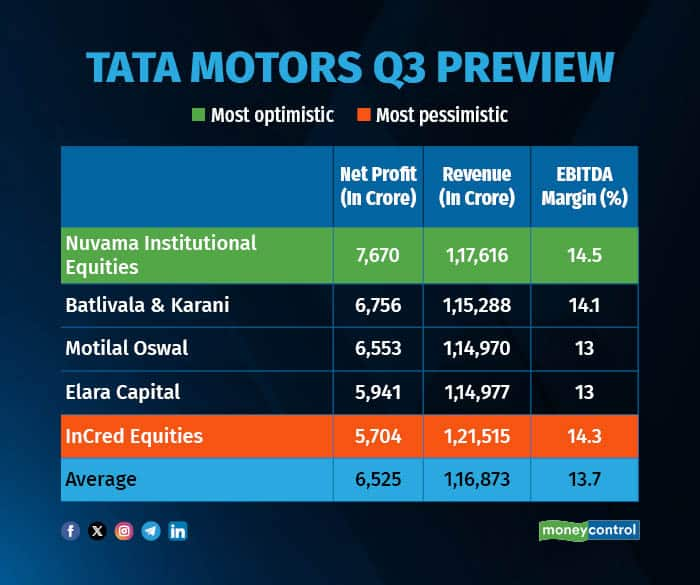Tata Motors Q3 Preview: Net profit may fall 7%, margins likely to contract on negative operating leverage
Tata Motors Q3 Preview: Net profit may fall 7%, margins likely to contract on negative operating leverage
Tata Motors' shares have tumbled almost 18 percent over the last three months.
Tata Motors, India's largest electric vehicle manufacturer, is set to release its earnings report for the third fiscal quarter of FY25 on January 29. Analysts expect an uptick in revenue, driven by a decent JLR performance and domestic passenger vehicle business. However, margins could come under pressure, a host of auto analysts say.

There is a serious divergence in the earnings estimates of different analysts polled by Moneycontrol, with the most optimistic estimate seeing a nine percent jump in net profit, while the most pessimistic projection predicts a 19 percent fall in Tata Motors' bottom-line.
Domestic Performance Boost: Growth in the Indian passenger vehicle and commercial vehicle businesses is expected to support the company’s overall performance. Analysts project an 8-11 percent year-on-year increase in consolidated revenue, aided by improved sales volumes and higher realizations in both segments.
What to look out for in the quarterly show?
Investors will closely track management commentary on JLR’s demand trends, particularly in the European and Chinese markets, and its margin trajectory. Any signs of sustained softness could impact future earnings. Tata Motors’ position as a leader in India’s EV market adds a layer of interest. Updates on the company’s EV bookings and production ramp-up will be keenly watched.
Read more: Nvidia’s $465 billion DeepSeek rout is largest in market history
Tata Motors shares closed at Rs 733, lower by almost 3 percent from the last close on the NSE on January 27. Tata Motors' stock price has corrected nearly 18 percent in the last three months.
Disclaimer: The views and investment tips expressed by investment experts on Moneycontrol.com are their own and not those of the website or its management. Moneycontrol.com advises users to check with certified experts before taking any investment decisions.




Comments
Post a Comment